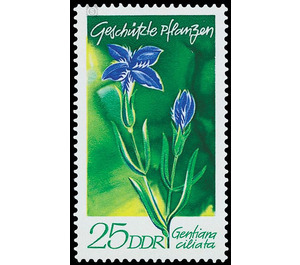Protected native plants - Germany / German Democratic Republic 1970 - 25 Pfennig
Theme: Flora
| Country | Germany / German Democratic Republic |
| Issue Date | 1970 |
| Face Value | 25.00 |
| Color | multi-colored green |
| Perforation | K 14 |
| Printing Type | Photogravure |
| Stamp Type | Postage stamp |
| Item Type | Stamp |
| Chronological Issue Number | 1307 |
| Chronological Chapter | GER-DDR |
| SID | 818736 |
| In 15 Wishlists | |
Protected plants The Ministry of Posts and Telecommunications of the German Democratic Republic publishes six multicolored special postal stamps with images of protected plants. Gentiana ciliata L. (25 Pfennig value) The eyelash gentian from the gentian family Gentianaceae is characterized by numerous blue flowers with fringed crown-lobes and narrow-lipped leaves. Its heyday is in late summer. As a typical calcareous plant of the dry and nutrient-poor grasslands, it is mainly distributed in the Thuringian districts and in the Central German dry area (Halle, Magdeburg districts) on corresponding sun-exposed sites. Its total area includes southern and central Europe. In the GDR, the plant reaches the northern limit of its distribution.


